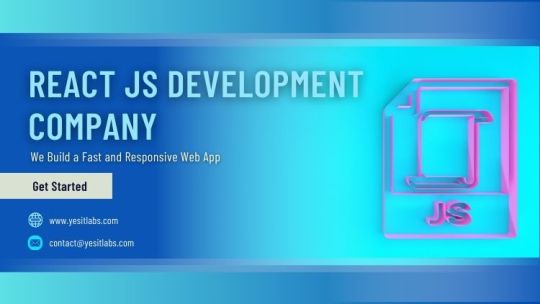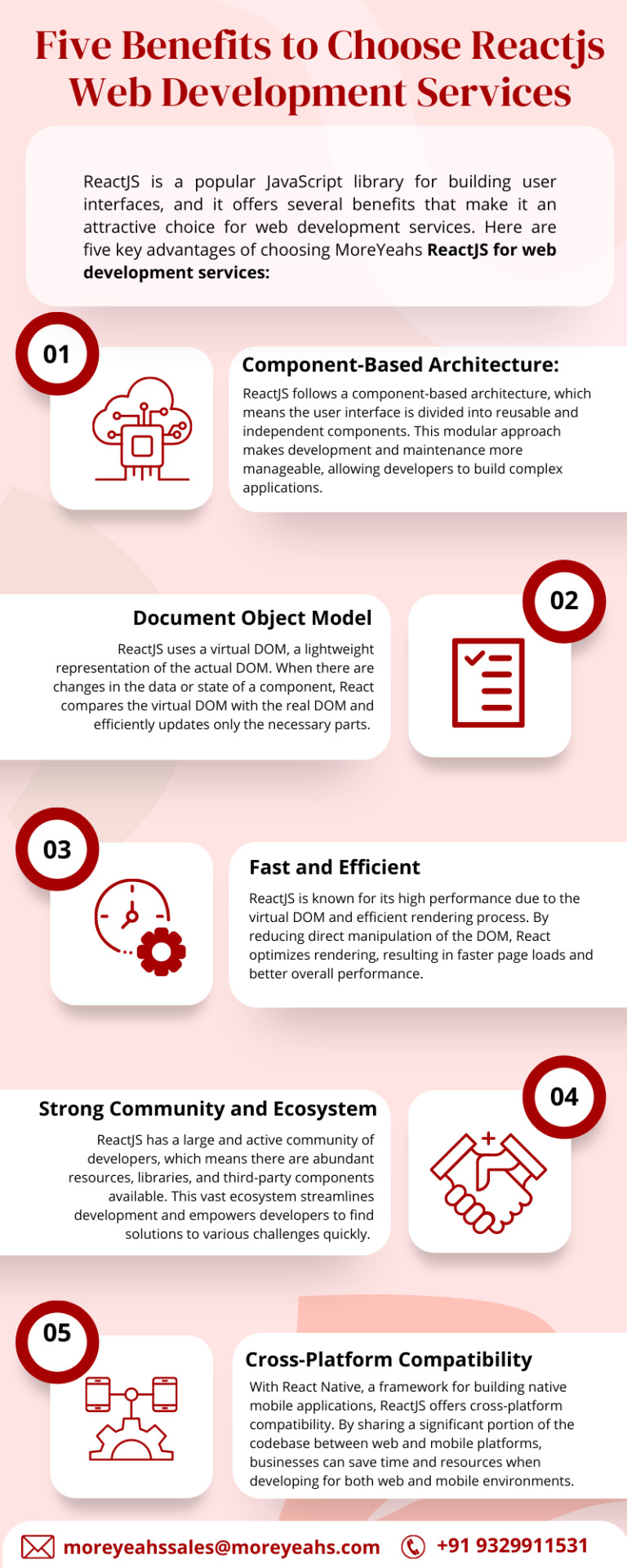#reactjs web development Company
Explore tagged Tumblr posts
Text
#Building eCommerce sites with React#hire reactjs developers#React eCommerce framework#React.js performance optimization#reactjs web development company#Scalable eCommerce solutions#top reactjs development company
0 notes
Text
Looking for the top ReactJS web development company in the USA for 2024? Our expert team delivers high-performance, scalable web applications using the latest ReactJS technology. Boost your business with cutting-edge web solutions today!
#inwizards software technology#reactjs#ReactJS web development company#ReactJS Development Company#ReactJS Development Service#reactjs development company in usa#ReactJS Web Development
0 notes
Text
Embracing ReactJS for Enterprise Application Development in 2024
Clearly, you’re seeking strategies to boost your business productivity. And for this, developing a high-level application that aligns with your business needs is the primary focus. A properly structured application can easily manage large databases, integrate with third-party systems, provide real-time analytics, and support various user roles.
0 notes
Text
7 Benefits to Get React JS Development Services (2024)
Unlock the power of React JS in 2024. This video explores 7 key benefits of React development services, showing you how to build modern, user-friendly web apps. Watch now & boost your development edge. Contact Moreyeahs today For React JS Development Services. For more info, visit:https://www.moreyeahs.com/services/web-development-services/react/
0 notes
Text
Why Choose Headless Ecommerce With Shopify?
Headless ecommerce with Shopify offers unparalleled advantages for businesses seeking to elevate their online presence. By partnering with NinjaTech, clients gain access to custom ReactJS development solutions that leverage Shopify's powerful platform, delivering exceptional user experiences and driving business growth. With a focus on innovation, flexibility, and reliability, NinjaTech continues to redefine the ecommerce landscape, empowering businesses to thrive in the digital era.
#ReactJS Development Company#ReactJS Development Services#Custom ReactJS Development Solutions#Hire Dedicated ReactJS Developers#ReactJS Web Development Company
1 note
·
View note
Text

At Shiv Technolabs, we provide custom Reactjs development services. Our team of skilled Reactjs developers specializes in creating immersive and engaging user interfaces that captivate your audience and keep them coming back for more.
Furthermore, we ensure quick web experiences that load fast and respond seamlessly to user interactions. Whether you're a startup or an established enterprise, our custom Reactjs development services are designed to take your online business to new heights.
0 notes
Text
IBR Infotech stands out as the premier ReactJS web development company, providing top-notch and cost-effective solutions tailored to your business needs. Contact us today for comprehensive ReactJS development services and elevate your online presence with cutting-edge technology.
#ReactJS web development company#ReactJS web development service#ReactJS web development company in USA#ReactJS web development services in uk
0 notes
Text
The Role of React.js in Shaping Modern Web Development

Utilising React, a component of the JavaScript language, has numerous benefits. React products are easy to scale, have workflow patterns for convenient teamwork, have legible and maintainable UI code, and much more. All of this is made possible by the single language used for the server, client, and mobile aspects. React JS web development services and other JS technologies have been employed by industry leaders in some of the most popular applications that define their respective markets (Facebook, Instagram, and Reddit are the most notable examples).
Contemporary, React js web development company prepares a popular JavaScript package used to create user interfaces (UIs). It has become incredibly important and popular because of several important factors. The following justifies the importance of React JS in contemporary web development.
Component-based architecture
One of the core ideas of React JS, a well-liked JavaScript user interface library, is component-based architecture. Using this architectural method, the user interface is divided into several independent and reusable parts. Every component is a building block for creating intricate user interfaces by encapsulating its logic, state, and rendering. The react js web development company develops the process, which is made simpler by this modular design, which lets programmers concentrate on certain areas of the application without worry.
In the end, this method encourages the development of scalable applications. New components can be introduced as a project gets more complicated, and already existing ones can be changed or combined to meet evolving needs. Because of its flexibility and modularity, React js web development services component-based design is an effective tool for creating user interfaces that can change to meet the demands of the application and its users while being simple to build and test.
Virtual DOM
A fundamental idea of React js web development company, the Virtual Document Object Model (DOM) is essential to improving the speed of online apps. React makes use of the Virtual DOM, a virtual representation of the DOM, as opposed to working directly with the actual DOM. This virtual representation serves as a bridge between the browser's rendering engine and the state of the application. It is a small, in-memory replica of the real DOM.
The development process is made simpler by using the Virtual DOM. Working with a consistent, virtual representation of the Document Object Model (DOM) facilitates reasoning and state management of UI components for developers. Performance can be further enhanced by batching and optimising several updates using this method.
Unidirectional data flow
The fundamental architectural principle of React, known as Unidirectional Data Flow, controls the flow and manipulation of data inside React applications. Data travels in a single, strict direction in this design, which is often referred to as one-way binding: from parent components to child components. This design decision makes the application's information flow simpler, which facilitates management and understanding.
Typically, parent components also called "containers" or "smart components" are where data is kept and managed in React applications. The child components of these parent components render and show the data that their parent components feed down to them. The react js web development services provide data that child components acquire from their parents that cannot be directly changed or altered. Whenever modifications are required, child components usually use callbacks or events to inform their parent components of the changes, enabling the parent component to update the data.
Reusable UI Component
One essential and effective component of creating contemporary web applications is the idea of reusable user interface components. Developers are encouraged by React js web development services' component-based architecture to divide the user interface into modular, self-contained components, each of which is in charge of a distinct aspect of the UI and has its own behaviour and style.
Thus, these reusable parts can be distributed around many projects or even the larger React community. This saves a great deal of time and effort because components made for one application can be readily repurposed in completely different ones. React js web development companies have access to a plethora of open-source component libraries and repositories that facilitate the sharing and reuse of tested and validated real-world components.
Rich Ecosystem and community support
Its broad acceptance and efficacy as a web development framework are largely due to its robust ecosystem and robust community support. Thanks to a wide range of third-party libraries, tools, and frameworks that improve its functionality and expedite the development process, React's popularity goes beyond its core library.
React js web development services are genuinely unique because of its active and cooperative community. Through sharing their expertise and experiences, as well as by developing new libraries, tools, and resources, the React development community actively contributes to the ecosystem. Because of everyone's combined efforts, there is an abundance of open-source projects, documentation, and online courses that make learning and using React js development services make all activities easier and more productive.
Cross-platform development
Cross-platform mobile application development is made possible by the robust framework known as React Native, which is an extension of the React ecosystem. It enables developers to use JavaScript and React ideas to create native mobile apps for the iOS and Android platforms. This method is revolutionary because it makes the most of the abilities and experience already possessed by React JS developers, enabling them to produce native-looking and feeling mobile applications with minimal platform-specific language and technology learning.
With React js web development services, you can work with an extensive library of pre-made, platform-specific components that mimic the appearance and functionality of native elements like input fields, buttons, and navigation bars. This guarantees a native user experience, seamless performance, and access to device-specific functionality for apps made using React Native. With React Native, developers may write native Swift, Objective-C, or Java code that can be easily merged with the JavaScript codebase, even for platform-specific scenarios.
Conclusion
Because of its component-based architecture, virtual DOM, unidirectional data flow, reusability, vibrant ecosystem, cross-platform development capabilities, and performance optimization features, React js web development services have become indispensable in contemporary web development. It encourages code reuse and maintainability while enabling developers to create highly interactive and scalable user interfaces.
One of the top React JS web development companies in India is IT Services India. Our team comprises highly experienced individuals with years of experience in developing online and mobile applications that are easy to use. Their developers create reliable React js apps that are customised to the demands and specifications of the client using the newest technologies. If you want React JS web development services for your business then do connect with IBR Infotech which will provide you with the solution to every problem.
0 notes
Text

How a React JS Development Company Can Help You Build a Fast and Responsive Web App
Maximize the potential of your web app through our React JS Development Company. Improve speed, responsiveness, and user experiences. Uncover possibilities today
#React JS Development Company#reactjs web development company#hire react js expert#reactjs developers for hire
0 notes
Text
Exceptional ReactJS Development Services by SMT Labs
Are you in search of a distinguished ReactJS Development Company? Look no further than SMT Labs. We specialize in providing exceptional React JS development services, meticulously crafted to cater to your specific business requirements. Our offerings encompass a wide spectrum, ranging from custom ReactJS development to seamless UI/UX design and development.
#ReactJS Development Company#Top React Services#react js development services#reactjs web development company#react js web development company
0 notes
Text
JavaScript Fundamentals
I have recently completed a course that extensively covered the foundational principles of JavaScript, and I'm here to provide you with a concise overview. This post will enable you to grasp the fundamental concepts without the need to enroll in the course.
Prerequisites: Fundamental HTML Comprehension
Before delving into JavaScript, it is imperative to possess a basic understanding of HTML. Knowledge of CSS, while beneficial, is not mandatory, as it primarily pertains to the visual aspects of web pages.
Manipulating HTML Text with JavaScript
When it comes to modifying text using JavaScript, the innerHTML function is the go-to tool. Let's break down the process step by step:
Initiate the process by selecting the HTML element whose text you intend to modify. This selection can be accomplished by employing various DOM (Document Object Model) element selection methods offered by JavaScript ( I'll talk about them in a second )
Optionally, you can store the selected element in a variable (we'll get into variables shortly).
Employ the innerHTML function to substitute the existing text with your desired content.
Element Selection: IDs or Classes
You have the opportunity to enhance your element selection by assigning either an ID or a class:
Assigning an ID:
To uniquely identify an element, the .getElementById() function is your go-to choice. Here's an example in HTML and JavaScript:
HTML:
<button id="btnSearch">Search</button>
JavaScript:
document.getElementById("btnSearch").innerHTML = "Not working";
This code snippet will alter the text within the button from "Search" to "Not working."
Assigning a Class:
For broader selections of elements, you can assign a class and use the .querySelector() function. Keep in mind that this method can select multiple elements, in contrast to .getElementById(), which typically focuses on a single element and is more commonly used.
Variables
Let's keep it simple: What's a variable? Well, think of it as a container where you can put different things—these things could be numbers, words, characters, or even true/false values. These various types of stuff that you can store in a variable are called DATA TYPES.
Now, some programming languages are pretty strict about mentioning these data types. Take C and C++, for instance; they're what we call "Typed" languages, and they really care about knowing the data type.
But here's where JavaScript stands out: When you create a variable in JavaScript, you don't have to specify its data type or anything like that. JavaScript is pretty laid-back when it comes to data types.
So, how do you make a variable in JavaScript?
There are three main keywords you need to know: var, let, and const.
But if you're just starting out, here's what you need to know :
const: Use this when you want your variable to stay the same, not change. It's like a constant, as the name suggests.
var and let: These are the ones you use when you're planning to change the value stored in the variable as your program runs.
Note that var is rarely used nowadays
Check this out:
let Variable1 = 3; var Variable2 = "This is a string"; const Variable3 = true;
Notice how we can store all sorts of stuff without worrying about declaring their types in JavaScript. It's one of the reasons JavaScript is a popular choice for beginners.
Arrays
Arrays are a basically just a group of variables stored in one container ( A container is what ? a variable , So an array is also just a variable ) , now again since JavaScript is easy with datatypes it is not considered an error to store variables of different datatypeslet
for example :
myArray = [1 , 2, 4 , "Name"];
Objects in JavaScript
Objects play a significant role, especially in the world of OOP : object-oriented programming (which we'll talk about in another post). For now, let's focus on understanding what objects are and how they mirror real-world objects.
In our everyday world, objects possess characteristics or properties. Take a car, for instance; it boasts attributes like its color, speed rate, and make.
So, how do we represent a car in JavaScript? A regular variable won't quite cut it, and neither will an array. The answer lies in using an object.
const Car = { color: "red", speedRate: "200km", make: "Range Rover" };
In this example, we've encapsulated the car's properties within an object called Car. This structure is not only intuitive but also aligns with how real-world objects are conceptualized and represented in JavaScript.
Variable Scope
There are three variable scopes : global scope, local scope, and function scope. Let's break it down in plain terms.
Global Scope: Think of global scope as the wild west of variables. When you declare a variable here, it's like planting a flag that says, "I'm available everywhere in the code!" No need for any special enclosures or curly braces.
Local Scope: Picture local scope as a cozy room with its own rules. When you create a variable inside a pair of curly braces, like this:
//Not here { const Variable1 = true; //Variable1 can only be used here } //Neither here
Variable1 becomes a room-bound secret. You can't use it anywhere else in the code
Function Scope: When you declare a variable inside a function (don't worry, we'll cover functions soon), it's a member of an exclusive group. This means you can only name-drop it within that function. .
So, variable scope is all about where you place your variables and where they're allowed to be used.
Adding in user input
To capture user input in JavaScript, you can use various methods and techniques depending on the context, such as web forms, text fields, or command-line interfaces.We’ll only talk for now about HTML forms
HTML Forms:
You can create HTML forms using the <;form> element and capture user input using various input elements like text fields, radio buttons, checkboxes, and more.
JavaScript can then be used to access and process the user's input.
Functions in JavaScript
Think of a function as a helpful individual with a specific task. Whenever you need that task performed in your code, you simply call upon this capable "person" to get the job done.
Declaring a Function: Declaring a function is straightforward. You define it like this:
function functionName() { // The code that defines what the function does goes here }
Then, when you need the function to carry out its task, you call it by name:
functionName();
Using Functions in HTML: Functions are often used in HTML to handle events. But what exactly is an event? It's when a user interacts with something on a web page, like clicking a button, following a link, or interacting with an image.
Event Handling: JavaScript helps us determine what should happen when a user interacts with elements on a webpage. Here's how you might use it:
HTML:
<button onclick="FunctionName()" id="btnEvent">Click me</button>
JavaScript:
function FunctionName() { var toHandle = document.getElementById("btnEvent"); // Once I've identified my button, I can specify how to handle the click event here }
In this example, when the user clicks the "Click me" button, the JavaScript function FunctionName() is called, and you can specify how to handle that event within the function.
Arrow functions : is a type of functions that was introduced in ES6, you can read more about it in the link below
If Statements
These simple constructs come into play in your code, no matter how advanced your projects become.
If Statements Demystified: Let's break it down. "If" is precisely what it sounds like: if something holds true, then do something. You define a condition within parentheses, and if that condition evaluates to true, the code enclosed in curly braces executes.
If statements are your go-to tool for handling various scenarios, including error management, addressing specific cases, and more.
Writing an If Statement:
if (Variable === "help") { console.log("Send help"); // The console.log() function outputs information to the console }
In this example, if the condition inside the parentheses (in this case, checking if the Variable is equal to "help") is true, the code within the curly braces gets executed.
Else and Else If Statements
Else: When the "if" condition is not met, the "else" part kicks in. It serves as a safety net, ensuring your program doesn't break and allowing you to specify what should happen in such cases.
Else If: Now, what if you need to check for a particular condition within a series of possibilities? That's where "else if" steps in. It allows you to examine and handle specific cases that require unique treatment.
Styling Elements with JavaScript
This is the beginner-friendly approach to changing the style of elements in JavaScript. It involves selecting an element using its ID or class, then making use of the .style.property method to set the desired styling property.
Example:
Let's say you have an HTML button with the ID "myButton," and you want to change its background color to red using JavaScript. Here's how you can do it:
HTML: <button id="myButton">Click me</button>
JavaScript:
// Select the button element by its ID const buttonElement = document.getElementById("myButton"); // Change the background color property buttonElement.style.backgroundColor = "red";
In this example, we first select the button element by its ID using document.getElementById("myButton"). Then, we use .style.backgroundColor to set the background color property of the button to "red." This straightforward approach allows you to dynamically change the style of HTML elements using JavaScript.
#studyblr#code#codeblr#css#html#javascript#java development company#python#study#progblr#programming#studying#comp sci#web design#web developers#web development#website design#ui ux design#reactjs#webdev#website#tech
397 notes
·
View notes
Text
Unveil ReactJS Website Development Cost in the US. Explore factors affecting cost & get a budget estimate for your project.
#inwizards software technology#Reac#Reactjs#ReactJS Web Development Company#ReactJS Development Services#ReactJS Development Company#ReactJS Web Development Companies
0 notes
Text
Boost Your Business: Why Hire ReactJS Web App Developers
Businesses are always competing. And we know how important it is to have the best of the best service providers. So, you must be very selective when choosing them to get the best outcome. Companies trying to enhance their digital presence and while striving for innovation, hiring the right ReactJS Web Development company has become more critical and essential than ever.
0 notes
Text

Five Benefits to Choose Reactjs Web Development Services
Discover the fice benefits of choosing ReactJS web development services. MoreYeahs has 10+ years of experience experts that can migrate your website from any JavaScript platform to React without affecting your business. Give a visit to discuss your requirements: https://www.moreyeahs.com/services/web-development-services/react/
#reactjs web development company#reactjs web development services#reactjs development company#reactjs development services#reactjs services#moreyeahs
1 note
·
View note
Text

Why Choose Headless Ecommerce With Shopify?
In the fast-paced world of digital commerce, businesses are continually seeking innovative ways to enhance their online presence and streamline operations. One strategy that's gaining traction is headless ecommerce, where the frontend presentation layer is decoupled from the backend functionality. At the forefront of this movement stands NinjaTech, a pioneering company specializing in ReactJS development, offering custom solutions and services to businesses worldwide. Let's explore why NinjaTech opts for Shopify as its platform for implementing headless ecommerce solutions while weaving in the specified keywords seamlessly.
Flexibility and Customization: As a leading ReactJS development company, NinjaTech understands the importance of flexibility and customization. With Shopify's robust API capabilities, NinjaTech can seamlessly integrate frontend storefronts with various backend systems, delivering tailored ecommerce experiences that align with clients' unique requirements.
Speed and Performance: Speed and performance are paramount in the digital realm. By decoupling the frontend from the backend using Shopify's platform, NinjaTech ensures lightning-fast load times and optimal user experiences. This synergy between ReactJS and Shopify's scalable infrastructure guarantees swift page loads and seamless navigation for users, ultimately enhancing conversion rates.
Innovative User Experiences: NinjaTech excels in crafting innovative user experiences through its expertise in ReactJS development. Leveraging modern web technologies, NinjaTech builds dynamic storefronts that captivate and engage users. With Shopify's support, NinjaTech can implement cutting-edge features and functionalities, delivering immersive shopping experiences that drive customer satisfaction and loyalty.
Future-Proofing: In an ever-evolving digital landscape, adaptability is key to sustained success. NinjaTech future-proofs its solutions by embracing headless ecommerce with Shopify. This strategic choice enables seamless adaptation to emerging technologies and consumer trends, ensuring clients stay ahead of the curve without the hassle of platform migrations.
Scalability and Reliability: As a trusted ReactJS web development company, NinjaTech prioritizes scalability and reliability. With Shopify's cloud-based infrastructure, NinjaTech can confidently scale ecommerce operations to cater to businesses of all sizes. The platform's robust architecture and 99.99% uptime guarantee ensure uninterrupted service, even during peak traffic periods.
Conclusion:
Headless ecommerce with Shopify offers unparalleled advantages for businesses seeking to elevate their online presence. By partnering with NinjaTech, clients gain access to custom ReactJS development solutions that leverage Shopify's powerful platform, delivering exceptional user experiences and driving business growth. With a focus on innovation, flexibility, and reliability, NinjaTech continues to redefine the ecommerce landscape, empowering businesses to thrive in the digital era.
#ReactJS Development Company#ReactJS Development Services#Custom ReactJS Development Solutions#Hire Dedicated ReactJS Developers#ReactJS Web Development Company
0 notes